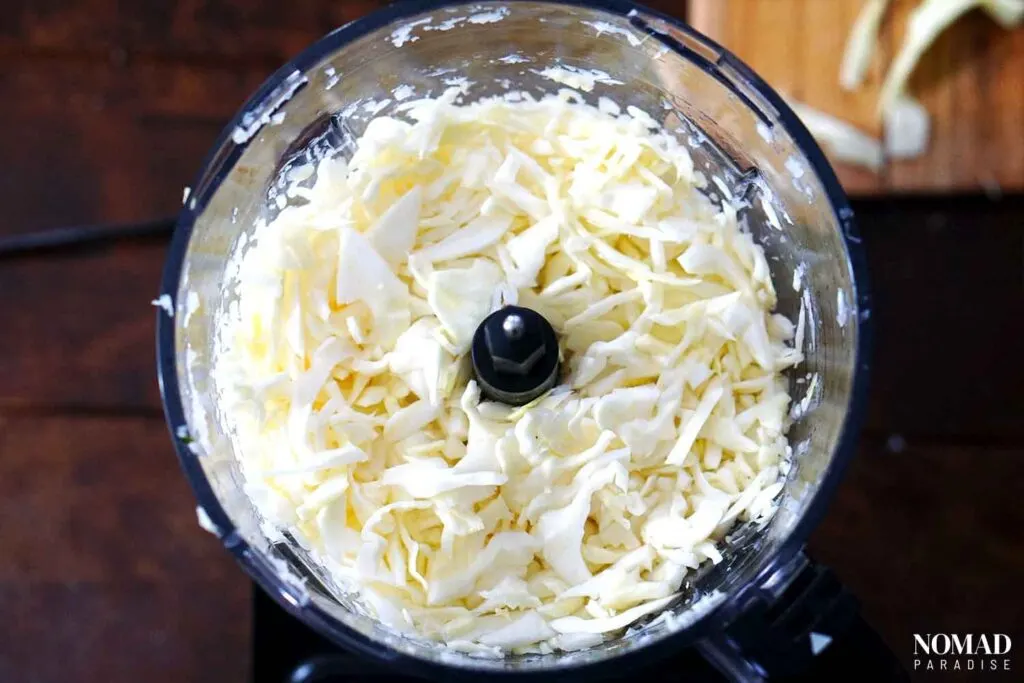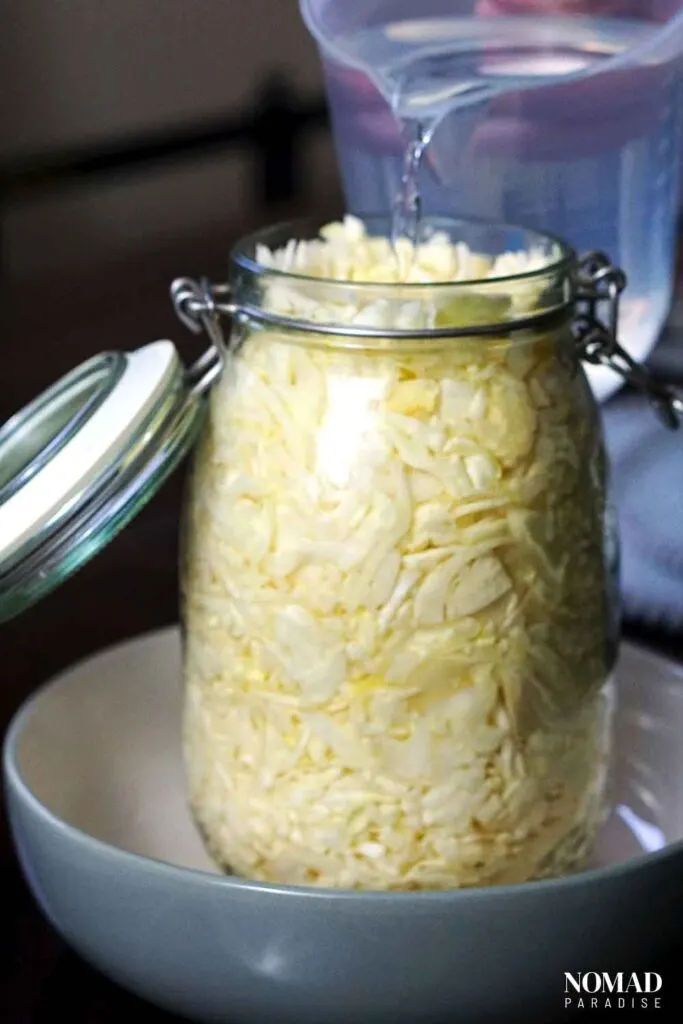This website may contain affiliate links and advertising so that we can provide recipes and guides at no additional cost to you. Learn more
Our simple sour cabbage or sauerkraut recipe may be German by name, but this diverse and hugely popular dish can be used in so many different ways, and has been an important staple in cuisines all over the world for thousands of years.

Sour Cabbage/Sauerkraut Recipe
The possibilities are endless with this nourishing dish, which can be found in so many of Europe’s most beloved dishes. Sauerkraut, or sour cabbage, is far more than simple food, and rightly plays an important role in the history, heritage, and cuisine of so many different countries.

What is Sour Cabbage or Sauerkraut?
Believed to have been introduced to Europe by the Mongol Empire from what is today China, but back then, a region referred to as Tartary, the practice of fermenting raw cabbage long predates its arrival in Europe, some thousand or so years ago.
Our recipe, however, honors the dish’s deep roots in European cuisine. While commonly referred to as sauerkraut, its German name, fermented or pickled sour cabbage is prolific in many Central and European cuisines, especially the likes of Polish, Ukrainian, and Moldovan cuisine, among others.
Put simply, sour cabbage is a dish of finely shredded cabbage, pickled by a process of lactic acid fermentation, which is commonly achieved by packing the cabbage tightly into a container with water, salt, and additional ingredients, such as sugar.
Sour cabbage has a very long shelf life, which is a key reason why it become so important in various Central and Eastern European cuisines, as it was an inexpensive food you could store and eat through the winter.
Variations
Sour cabbage is used in a vast array of different dishes, a small selection of which we have featured in our ‘serving suggestions’ section at the end of this recipe.
When it comes to sour cabbage itself, while the pickling process remains largely the same across Europe, various cuisines and countries do have their slight variations and additional ingredients, some of which are as follows:
Carrot – Especially in Baltic cuisines and the likes of Polish cuisine, it is very common to add shredded carrot into the mixture with the cabbage.
Apple – Not necessarily shredded, but some regions and cuisines will add quartered, or even whole, apples into their sour cabbage mixture, largely to add flavor.
Berries and Seeds – Carraway seeds, juniper berries, cranberries, and black peppercorns, among others, are all additional ingredients that can be added to the shredded sour cabbage mixture, depending on region and preference.
Double Fermentation – Especially in Russia, the cabbage is put through a process called ‘double fermentation’, where once the initial sour cabbage is ready, additional fresh cabbage, along with (but not exclusively) a range of additional ingredients such as beets, apple, cranberries, and even watermelon, are added to the sour cabbage. The entire mixture is then left to ferment again, with the idea being that the additional ingredients balance the sourness of the cabbage.
Recipe Ingredients
To make our sour cabbage recipe, you’ll need the following ingredients:

- Cabbage – 5.5 lb or 2.5 kg white cabbate
- Salt – 4 tbsp table salt
- Water – 4 and 1/4 cups or 1 liter of water (boiled and cooled down)
- Black Peppercorns – 10 black peppercorns
- Bay Leaves – 3-4 bay leaves
- Sugar – 2 tbsp granulated sugar
Step-by-Step Instructions
Step 1 – Clean the cabbage (wash it and throw away the outer leaves) and then cut each cabbage in four.

Step 2 – Remove the hard core from each cabbage quarter.

Step 3 – Shred the cabbage (either shred it in a food processor or finely slice it with a mandoline or with a chef’s knife).
We prefer the quicker version of shredding the cabbage in a food processor (using the slicing disc).

Step 4 – Put the sliced cabbage, peppercorns, and bay leaves (divided up between 2 jars of 1.9 qt/1.8 liters volume) in the jars and press the cabbage down.

We used a rolling pin to press the cabbage down so it was very compressed and that it would fit in 2 jars.


Step 5 – Dissolve the salt in the water.

Step 6 – Add the sugar to the water.

Step 7 – Pour the water (with the dissolved sugar and salt in it) over the cabbage.


Step 8 – Cover with some breathable material (such as cheesecloth).
Don’t close the lid and don’t make it airtight! The cabbage needs to breathe.


Step 9 – For 3 days, twice a day (once in the morning and once in the evening), uncover the sour cabbage and press down with a wooden spoon to release the gases from the cabbage.
If you skip this step, the sour cabbage will be bitter.
Note: The sour cabbage has a particularly strong, pungent smell while it’s fermenting during these three days. And, because you can’t close the lid or make it airtight, it will release these smells in the air in the space where you stored it. If you can, try to store it in a place where the smell won’t bother you (like in the garage or a pantry).

Step 10 – After 3 days (72 hours), you can close the lids and put the sauerkraut (sour cabbage) in the fridge.
You can enjoy it as is or in numerous recipes such as cabbage pies or sauerkraut soup.

Serving Suggestions
In all honesty, you could write a book on the number of ways sour cabbage is used in European cuisine, and not even come close to covering all of it.
I have vivid memories of sour cabbage from childhood. We would always have jars of it stored at home, and mom would use it in so many different dishes.
Kind of like pasta in Italian households, sour cabbage was that tried and trusted food that was always there for us, and we could call upon to be used as a filling, side dish, or eaten on its own.
If you are thinking of creative ways to use homemade sauerkraut, while this list barely scratches the surface of the possibilities, it will introduce you to some classic European dishes.
Meat – Especially in Germany, Austria, and other areas of Central Europe, such as Northern Italy, sauerkraut with pork, sausages, smoked meats, and plenty of specific meats depending on the region (e.g., Vienna sausages), is a dish enjoyed by millions, every single day.
Soups – One of the most common ways to use sauerkraut is in European soups, and as you can imagine the soups are vast and varied. Some common dishes to try include kapusniak of Ukrainian cuisine, bigos of Poland, known as ‘Hunter’s stew’, and sour shchi, a version of shchi, one of Russia’s national dishes, that uses sauerkraut instead of cabbage.
Placinte/Pies – In Romanian and Moldovan cuisine, sour cabbage or sauerkraut is a popular filling for placinte, a traditional rolled pastry.
Dumplings – The likes of pierogi in Polish cuisine and varenyky in Ukrainian cuisine can have both sweet and savory fillings, and sour cabbage is a common go-to for savory versions.
Vepřo Knedlo Zelo – The Czech national dish is a beloved and wholesome trio of roast pork, knedlo (traditional Czech bread dumplings), and sauerkraut, coated in gravy.
However you decide to enjoy this diverse dish, it’s pretty incredible to think humans have been fermenting cabbage in this way for thousands of years. Let me know in the comments below what fun and creative dishes you used your sour cabbage in.

Sour Cabbage/Sauerkraut Recipe Card

Ingredients
- 5.5 lb 2.5 kg white cabbage
- 4 tbsp table salt
- 4 and 1/4 cups 1 liter water, boiled and cooled down
- 10 black peppercorns
- 3-4 bay leaves
- 2 tbsp granulated sugar
Instructions
- Wash the cabbages and throw away the outer leaves, and then cut each cabbage in four.
- Remove the hard core from each cabbage quarter.
- Shred the cabbage (either in a food processor or a with mandoline or finely slicing it with a chef’s knife).
- Put the sliced cabbage, peppercorns, and bay leaves (divided up between 2 jars of 1.9 qt/1.8 liters volume) and press the cabbage down. We used a rolling pin to press the cabbage down so it was very compressed and that it would fit in 2 jars.
- Dissolve the salt in the water.
- Add the sugar to the water.
- Pour the water (with the dissolved sugar and salt in it) over the cabbage.
- Cover with some breathable material (such as cheesecloth). Don’t close the lid & don't make it airtight!
- For 3 days (72 hours), twice a day (once in the morning and once in the evening), uncover the sour cabbage and press down with a wooden spoon to release the gases from the cabbage. If you skip this step, the cabbage will be bitter.
- After 3 days (72 hours), you can close the lids and put the sauerkraut (sour cabbage) in the fridge to eat as is or to use it in various recipes.
Recipe Notes
You Might Also Like to Read
Save and Pin for Later
Keep our homemade sauerkraut/sour cabbage recipe for safekeeping by saving this article to one of your Pinterest recipe boards.

